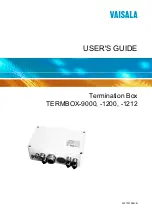
1-17
Cisco MGX 8850 (PXM1E/PXM45), Cisco MGX 8950, Cisco MGX 8830, and Cisco MGX 8880 Configuration Guide
Release 5.0.10, OL-3845-01 Rev. B0, August 16, 2004
Chapter 1 Preparing for Configuration
Guidelines for Creating an IP Address Plan
CiscoView is a CWM component that can be used independently of CWM to provide limited monitoring
and management capabilities.
To determine which versions of CWM and CiscoView are compatible with this release, refer to the
following release note documents:
•
Release Notes for Cisco MGX 8850 (PXM1E/PXM45), Cisco MGX 8950, and Cisco MGX 8830
Switches, Release 5.0.00.
•
Release Notes for the Cisco MGX 8880 Media Gateway, Release 5.0.00
For information on managing the switch with an SNMP manager, refer to the Cisco MGX 8850 SNMP
Reference, Release 4.
Physical Location of Cards and Lines in the Switch
Many configuration features depend on a specific hardware installation configuration. The following list
provides some samples of how the software configuration depends on the hardware installation:
•
The software for each switch supports a specific set of processor cards and service modules.
•
The software for each switch expects to find each card type in specific slots.
•
Redundant card configurations can require that redundant cards be placed in a specific relationship
to each other.
•
Redundant line configurations can require additional hardware and require that redundant lines be
be placed in a specific relationship to each other.
shows where each card can be installed, and it shows which front and back cards are
compatible with each other. Before starting switch configuration, take some time to review the card
redundancy and line redundancy planning information in the Cisco MGX 8850 (PXM1E/PXM45), Cisco
MGX 8950, Cisco MGX 8830, and Cisco MGX 8880 Hardware Installation Guide, Releases 2 Through
5. It is wise to review the hardware installation before you begin configuration. If the hardware
installation does not support the planned software configuration, either the hardware installation or the
software configuration must change.
Guidelines for Creating an IP Address Plan
This section discusses local connectivity through the PXM LAN port. For information on using terminal
servers, modems and CWM to remotely access the switch, see
Appendix C, “Supporting and Using
Additional CLI Access Options.”
You can access the switch through three types of user interfaces: CLI, SNMP, and CWM. The switch has
local ports in support of these interfaces, and each of these ports has a user-configurable IP address. The
local ports are as follows:
•
Console Port (CP)
•
Maintenance Port (MP)
•
LAN 1 port
•
ATM interface
Basic switch configuration and management can be completed by using a local terminal connected to the
console port. However, to configure and manage the switch from a LAN connection, a modem
connection, or with CWM, you need define an IP address for the appropriate interface.
















































